
BACKUP POWER
Current with 2011-2013
Electrical Codes

Contents
 Backup Power Supply
Backup Power Supply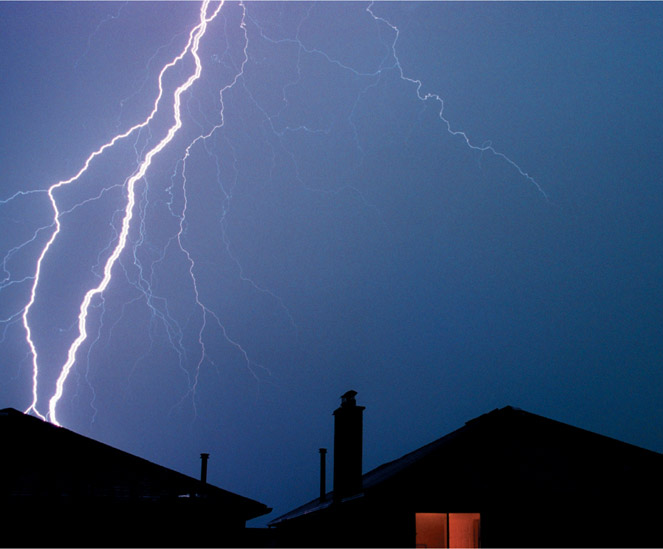
I nstalling a backup generator is an invaluable way to prepare your family for emergencies. The simplest backup power system is a portable gas-powered generator and an extension cord or two. A big benefit of this approach is that you can run a refrigerator and a few worklights during a power outage with a tool that can also be transported to remote job sites or on camping trips when its not doing emergency backup duty. This is also the least expensive way to provide some backup power for your home. You can purchase a generator at most home centers and be up and running in a matter of hours. If you take this approach, it is critically important that you make certain any loads being run by your generator are disconnected from the utility power source.
The next step up is to incorporate a manual transfer switch for your portable generator. Transfer switches are permanently hardwired to your service panel. They are mounted on either the interior or the exterior of your house between the generator and the service panel. You provide a power feed from the generator into the switch. The switch is wired to selected essential circuits in your house, allowing you to power lights, furnace blowers, and other loads that cant easily be run with an extension cord. But perhaps the most important job a transfer switch performs is to disconnect the utility power. If the inactive utility power line is attached to the service panel, backfeed of power from your generator to the utility line can occur when the generator kicks in. This condition could be fatal to line workers who are trying to restore power. The potential for backfeed is the main reason many municipalities insist that only a licensed electrician hook up a transfer switch. Using a transfer switch not installed by a professional may also void the warranty of the switch and the generator.
Automatic transfer switches turn on the generator and switch off the utility supply when they detect a significant drop in line voltage. They may be installed with portable generators, provided the generator is equipped with an electric starter.
Large standby generators that resemble central air conditioners are the top of the line in backup power supply systems. Often fueled by home natural gas lines or propane tanks that offer a bottomless fuel source, standby generators are made in sizes with as much as 20 to 40 kilowatts of outputenough to supply all of the power needs of a 5,000-sq.-ft. home.

Generators have a range of uses. Large hard-wired models can provide instant emergency power for a whole house. Smaller models (below) are convenient for occasional short-term backup as well as job sites or camping trips.
 Choosing a Backup Generator
Choosing a Backup Generator
A 2,000- to 5,000-watt gas-powered generator and a few extension cords can power lamps and an appliance or two during shorter-term power outages. Appliances must not be connected to household wiring and the generator simultaneously. Never plug a generator into an outlet. Never operate a generator indoors. Run extension cords through a garage door.
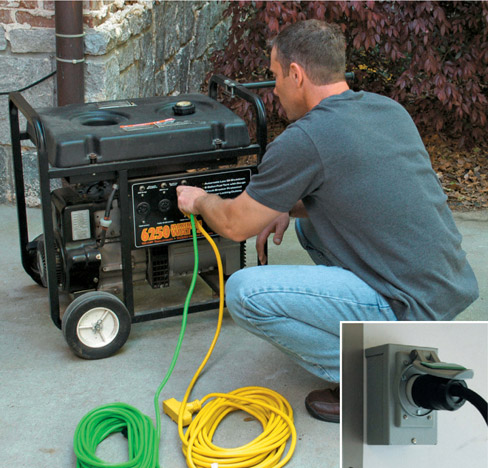
A permanent transfer switch patches electricity from a large portable generator through to selected household circuits via an inlet at your service panel (inset), allowing you to power hardwired fixtures and appliances with the generator.
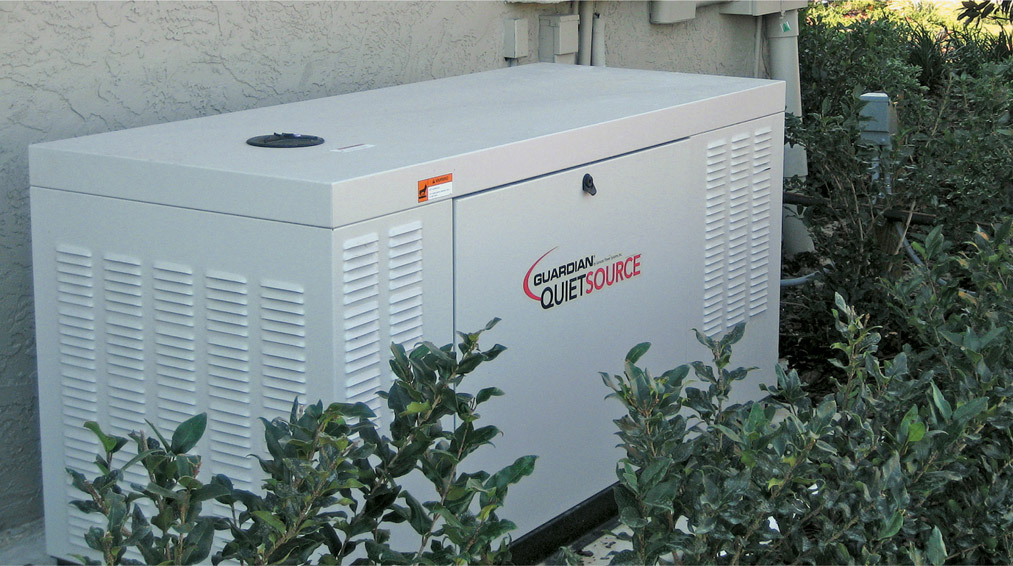
For full, on-demand backup service, install a large standby generator wired through to an automatic transfer panel. In the event of a power outage, the household system instantly switches to the generator.
 A Typical Backup System
A Typical Backup System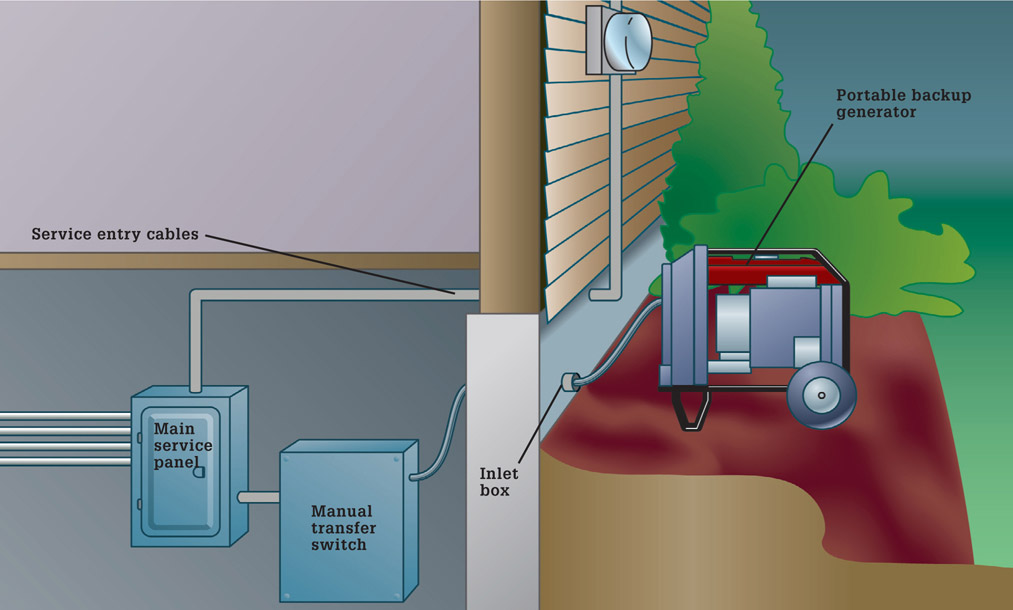
Backup generators supply power to a manual transfer switch, which disconnects the house from the main service wires and routes power from the generator through selected household circuits.
 Choosing a Generator
Choosing a GeneratorChoosing a generator for your homes needs requires a few calculations. The chart below gives an estimate of the size of generator typically recommended for a house of a certain size. You can get a more accurate number by adding up the power consumption (the watts) of all the circuits or devices to be powered by a generator. Its also important to keep in mind that, for most electrical appliances, the amount of power required at the moment you flip the ON switch is greater than the number of watts required to keep the device running. For instance, though an air conditioner may run on 15,000 watts of power, it will require a surge of 30,000 watts at startup (the power range required to operate an appliance is usually listed somewhere on the device itself). These two numbers are called run watts and surge watts. Generators are typically sold according to run watts (a 5,000-watt generator can sustain 5,000 watts). They are also rated for a certain number of surge watts (a 5,000-watt generator may be able to produce a surge of 10,000 watts). If the surge watts arent listed, ask or check the manual. Some generators cant develop many more surge watts than run watts; others can produce twice as much surge as run wattage.
Its not necessary to buy a generator large enough to match the surge potential of all your circuits (you wont be turning everything on simultaneously), but surge watts should factor in your purchasing decision. If you will be operating the generator at or near capacity, it is also a wise practice to stagger startups for appliances.
SIZE OF HOUSE (IN SQUARE FEET) | RECOMMENDED GENERATOR SIZE (IN KILOWATTS) |
Up to 2,700 | |
2,7003,700 | 1416 |
3,7004,700 |





 Backup Power Supply
Backup Power Supply

 Choosing a Backup Generator
Choosing a Backup Generator


